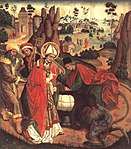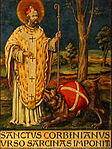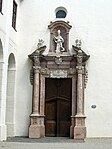Korbinian Bear

The Korbinian Bear is a bear depicted with a pack saddle , which goes back to a legend about the holy Korbinian , the founder of the diocese of Freising . He tore a pack animal belonging to Bishop Korbinian who was on a pilgrimage to Rome . The saint was able to tame the bear, as a punishment he then burdened him with his luggage and hiked with him to Rome, where Korbinian released the bear. "A simple interpretation of this symbolism sees the bishop of Freising himself in the bear, tamed by the grace of God, and in the pack saddle the burden of the episcopate borne by him ."
It appears in the city arms of Freising and Pick Lassenem as well as on the archbishop's arms of Cardinal Josef Ratzinger and the papal arms of Benedict XVI.
Pope Benedict XVI
The story of the Korbinian bear, especially his personal relationship with it, was told by Pope Benedict XVI. taken up in his address in front of the Munich Marian Column (see the Pope's visit to Bavaria , 2006). When he was facing the decision to succeed Bishop Korbinian in 1977, he remembered the Korbinian bear, which in Christian iconography symbolizes a beast of burden of God, which is constantly close to his because of the burden placed on him - expressed in the thoughts of St. Augustine of Hippo Client, God, stays. The Korbinian bear encouraged the Pope “to do my service with joy and confidence - thirty years ago as well as now in my new job - and to say my yes to God day after day: I have become a pack animal for you, but just now so I am 'always with you' […] The bear of St. Corbinian was released in Rome. In my case the Lord decided differently. ”An indication that as a Roman Curia Cardinal he could not retire a year earlier, but was elected Pope. “And so I am standing at the feet of the Marian Column again to implore the intercession and blessing of Our Lady, not only for the city of Munich and not only for the dear Bavaria, but for the Church of the whole world and for all good people Willing."
Sacred representation
The Korbinian altar of the Munich church St. Georg and also a statue of the bear (1761) in the parish church St. Marinus and Anianus in Rott am Inn come from the important sculptor of the South German Rococo, Ignaz Günther . St. Korbinian and the bear are depicted several times on the magnificent Korbinian altar (1480) of the late Gothic church of St. Korbinian in Unterassling , Tyrol , built between 1461–68 . The paintings are by the painter Friedrich Pacher (a relative of Michael Pacher ), the statue is one of the earliest personal works by the sculptor Hans Klocker . The late Gothic winged altar was once the high altar (main altar) of the church. When the side wings of the altar disappeared in the 19th century, its central part with the predella and the Korbinian statue in the church were rearranged. It was not until 2007 that the side wings of the Korbini Altar appeared at an art auction; in 2010 they were joined to the middle section and restored.
In the Benedictine monastery Scheyern an interesting will Nouveau - chasuble kept a on the embroidered image of the saint with the Corbinian is visible (bottom).
Painting by Jan Polack , 1489, Diözesanmuseum Freising
Panel painting in the Freising Cathedral of St. Maria and St. Korbinian
Copper engraving by Joseph Sebastian and Johann Baptist Klauber , approx. 1740–1750
Drawing by Cosmas Damian Asam , ca.1725
Representation of St. Korbinian in Unterassling , Tyrol
Individual evidence
- ↑ Iconographic-heraldic description of the coat of arms of Pope Benedict XVI. on the Vatican website .
- ^ Greetings from Pope Benedict XVI. in front of the Mariensäule in Munich on September 9, 2006.
- ↑ Korbinians altar from Assling in Tyrol.
- ↑ Restoration of the Korbini Altar , on the website of the Austrian Federal Monuments Office .











